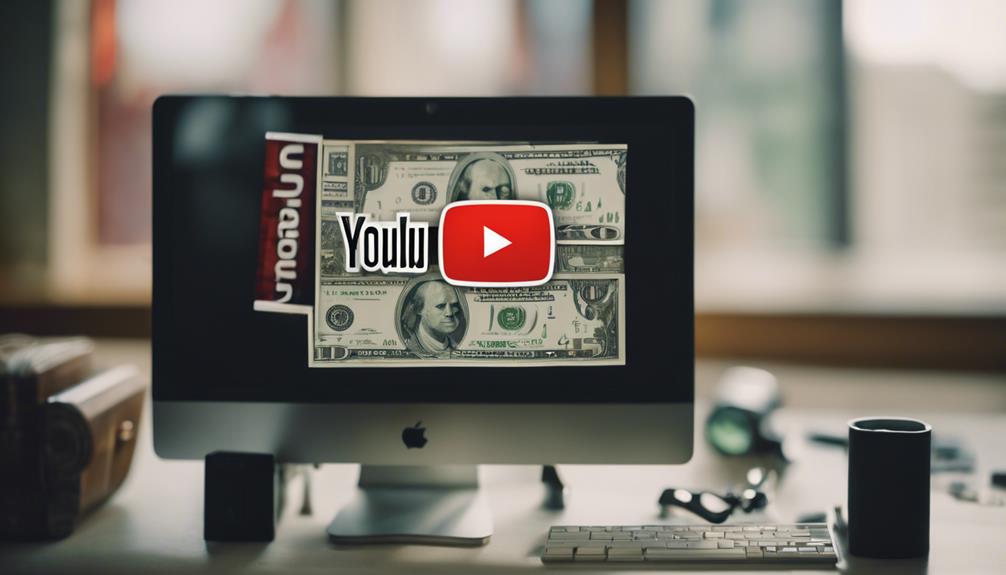
How many views do you need on YouTube to earn money?
Imagine you’ve got a billion views on your YouTube video – you’d be swimming in cash, right? Well, not exactly. The truth is, there’s no fixed number of views that’ll guarantee a certain amount of money.
It’s not as straightforward as you might think. YouTube’s monetization process involves several factors like the type of ads displayed, viewer demographics, and engagement metrics. So, while views are crucial, they’re just one piece of the puzzle.
Intrigued? Let’s peel back the layers to understand how this video-sharing platform calculates earnings.
Key Takeaways
- Views are the foundation of potential earnings, with more views generally leading to higher YouTube ad revenue.
- Earnings are influenced by viewer demographics, ad engagement rates, and audience retention, not just view numbers.
- SEO optimization of videos can boost view count and potential earnings by improving video discoverability.
- YouTube’s default payment threshold is $100, so creators must accumulate this amount in earnings before receiving a payout.
Understanding YouTube’s Partner Program

To truly grasp the earning potential on YouTube, you first need to understand how the YouTube Partner Program works. This program is a monetization platform that allows content creators to earn from their videos. The partner benefits are numerous and include revenue from ads, channel memberships, and access to YouTube’s Creator Support teams.
Revenue from ads is perhaps the most well-known monetization strategy. When you’re a YouTube Partner, ads are displayed on your videos, and you earn a share of the revenue. But that’s not the only way to make money. Channel memberships allow your most loyal fans to support you directly by paying a monthly fee. In return, they receive exclusive perks like badges, new emojis, and access to members-only videos.
Understanding these monetization strategies is key to maximizing your earnings on YouTube. It’s more than just views; it’s about leveraging the resources available to you as a YouTube Partner to create a diverse income stream. So don’t just focus on views, explore all the avenues of revenue that YouTube offers.
Eligibility Criteria for Monetization
Now that you’re familiar with the potential revenue streams within the YouTube Partner Program, let’s discuss the eligibility criteria you must meet to monetize your content.
To start, you need to live in a region where the Partner Program is available. If so, you’re off to a good start, but there are additional criteria. You must have over 1,000 subscribers and more than 4,000 watch hours in the past 12 months. These thresholds ensure that your channel has a solid, engaged audience before monetization kicks in.
Next, you’ll have to comply with all of YouTube’s policies and guidelines. This includes content guidelines, which dictate what you can and can’t post on your channel. Violations could result in monetization restrictions or even removal from the Partner Program.
Adherence to these content guidelines is crucial. Your content must be advertiser-friendly, meaning it mustn’t contain anything offensive, harmful, or inappropriate. Keep in mind, YouTube uses both algorithms and human review to enforce these rules.
Lastly, you must have an AdSense account linked to your YouTube channel. This is how YouTube will pay you for the ads shown on your videos. Following these criteria will set you on the path to monetization.
How YouTube Advertising Works
Understanding how YouTube advertising works is key to maximizing your earnings from your monetized channel. Essentially, advertisers pay YouTube to display their ads on videos. YouTube then shares a portion of this revenue with the video creators. This is where your ad targeting strategies come into play.
You can optimize ads to target specific demographics, interests, and behaviors to reach viewers who are most likely to engage with your content. The more specific and targeted your ads, the more likely they’re to generate revenue. Incorporating these strategies could be the difference between a trickle of income and a steady stream.
The next piece of the puzzle is Video SEO optimization. This is all about making sure your videos are easily discoverable. You need to use relevant keywords in your video titles, descriptions, and tags. YouTube’s algorithm favors videos that are highly relevant to users’ searches, so the better your SEO, the more likely your videos are to appear in search results. This directly influences the number of views your videos get, and thus, your potential earnings.
Calculating Potential Earnings
So, how do you go about calculating your potential earnings on YouTube? It’s all about understanding your video analytics and ad engagement rates.
Start by looking at your video’s views. Each view represents a potential consumer, so they’re the foundation of your earning potential. Then, consider your ad engagement. How many viewers actually interact with the ads on your video? This could be through clicking on the ad, watching it in full, or making a purchase. Your ad engagement rate is a crucial factor in your YouTube earnings.
Next, you’ll want to delve deeper into your video analytics. This includes analyzing your viewer demographics, watch time, and viewer retention rate. These figures can give you a better understanding of your audience and their behavior, which can be instrumental in increasing your ad engagement rates.
YouTube’s Payment Threshold

After calculating your potential earnings, it’s crucial to consider YouTube’s payment threshold, the minimum balance you need to have before you can receive a payout. This aspect directly influences your revenue flow and is integral to your financial planning.
Understanding YouTube’s payment threshold is as simple as recognizing these four key points:
- The default payment threshold for YouTube is $100. This means you won’t see a single penny until your earnings hit that mark.
- The threshold impacts how often you can expect to receive payments. If your channel generates less than $100/month, you’ll have to wait longer between payouts.
- Payment Schedule Insights indicate that YouTube processes payments around the 21st of every month. This means you must meet the threshold by the end of the previous month to receive payment.
- The threshold applies to each AdSense account, not per channel. So, if you operate multiple channels under one AdSense account, all their earnings contribute to the same threshold.
Understanding this framework allows you to strategize, plan your content, and optimize your channel effectively. Remember, mastering YouTube’s ecosystem is as important as creating engaging content. Now, you’re one step closer to transforming your creativity into earnings!
Other YouTube Earning Opportunities
Beyond ad revenue, you’ve got other routes to increase your YouTube income. Consider channel membership perks and merchandise shelf profits as viable options.
These alternatives not only diversify your income, but also deepen your connection with your audience.
Channel Membership Perks
In addition to ad revenue, channel membership perks offer another lucrative opportunity for you to monetize your YouTube presence. By offering membership exclusivity, you can increase subscriber engagement, which is crucial to your channel’s success.
- Exclusive Livestreams: Members-only livestreams give you a chance to engage with your most loyal fans.
- Members-Only Videos: Exclusive videos can include behind-the-scenes footage, bloopers, or special tutorials.
- Badges and Emojis: Customizable icons can be utilized to create a unique community experience.
- Priority in Comments and Chats: Members’ comments can be highlighted, making them feel more valued and encouraging further engagement.
Merchandise Shelf Profits
While channel membership perks can significantly boost your earnings, don’t overlook the potential of the merchandise shelf – another excellent profit-making feature on YouTube. Your product selection strategies and merchandise pricing tactics can significantly affect your overall income from this feature.
To give you a better idea, here’s a breakdown:
| Strategies | Impact | Examples |
|---|---|---|
| Product Selection | Decides appeal to the audience | Trending items, Channel-branded merchandise |
| Pricing Tactics | Influences sales volume | Competitive pricing, Discounts on bulk orders |
| Marketing | Drives visibility & purchase decisions | Promoting in videos, Linking in the description |
Maximizing Your YouTube Revenue

To truly maximize your YouTube revenue, it’s essential to understand and leverage the platform’s monetization features effectively. With the right video optimization techniques, you can significantly increase your earnings.
- Video Optimization: Enhance your video’s visibility by using SEO-friendly keywords, compelling titles, and engaging thumbnails. A well-optimized video attracts more views, leading to higher ad revenue.
- Influencer Collaborations: Partnering with influencers can boost your exposure exponentially. It’s a win-win situation; you gain access to their audience while providing them with fresh content.
- Monetization Features: Familiarize yourself with YouTube’s monetization features such as Super Chat, Memberships, and Merchandise Shelf. These features allow you to earn directly from your audience.
- Consistency: Regularly uploading quality content keeps your audience engaged and boosts your channel’s chances of being recommended by YouTube’s algorithm.
Common Pitfalls to Avoid
While you’re striving to boost your views and earn money on YouTube, it’s crucial to sidestep a few common pitfalls. Misunderstanding monetization rules or ignoring copyright laws can quickly derail your progress.
Let’s unpack these issues to ensure you’re building your platform on solid ground.
Misunderstanding Monetization Rules
Don’t let the allure of making money on YouTube cloud your understanding of its monetization rules, as falling into common pitfalls can prevent you from earning revenue. There are ad revenue misconceptions and monetization myths that you need to debunk to navigate the platform effectively.
Here are four errors commonly made:
- Believing in instant success: It’s not just about getting views. You need to have 1,000 subscribers and 4,000 watch hours within the past 12 months to qualify for YouTube Partner Program.
- Assuming all views are profitable: Not all views generate ad revenue. Only monetized views count towards your earnings.
- Ignoring YouTube’s guidelines: Violating community guidelines can lead to demonetization.
- Overestimating ad revenue: Understand that YouTube keeps 45% of ad revenues. Don’t set unrealistic expectations.
Avoid these pitfalls and you’re on your way to a lucrative YouTube career.
Ignoring Copyright Laws
Another pitfall that can jeopardize your YouTube earnings is disregarding copyright laws. The ‘Consequences of Ignorance’ are far-reaching and potentially devastating. Copyright infringement can lead to your YouTube video being taken down, or worse, your channel being suspended. This could have a significant impact on your revenue and audience base.
‘Plagiarism Dangers’ aren’t something to be taken lightly. Using someone else’s content without permission or proper attribution is a surefire way to lose credibility and jeopardize your earnings. To avoid this, always ensure you have the necessary rights to the content you upload. You’re crafting a brand, and protecting that brand should be your top priority. Ignorance isn’t an excuse, it’s a pitfall.


